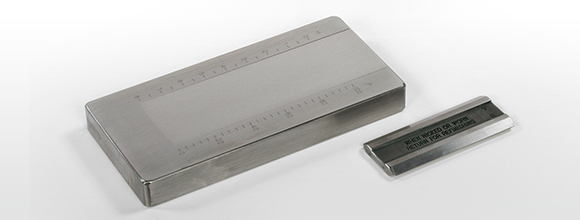The grind gage is used for the determination of the fineness of grain and large particles or agglomerates in a dispersion
In addition to our extensive range of stirring, dispersing and milling accessories, we produce varying designs on request.
Our experienced engineers are glad to advise you accordingly.

| Grind gage | Pulling-off surface | Range |
| Grind gage 25 | 50 x 130 mm | 0 - 25 µ (Micro) |
| Grind gage 50 | 50 x 130 mm | 0 - 50 µ (Micro) |
| Grind gage 100 | 50 x 130 mm | 0 - 100 µ (Micro) |
During the dispersion process solids of a coating material are
pulverized into smaller particles. The dispersion grade has an effect on
the physical and optical characteristics of the coating. The grind gage
is used for the determination of the fineness of grain and large
particles or agglomerates in a dispersion. It does not define the real
grain size or grain distribution. Grind gages are used for quality
inspection in a production, storage and application of dispersions in
the varnish, pigment, printing ink, paper, ceramic, pharma, food and
many other industries.
The grind gage is a flat steel standard
with one or two flat, wedge-shaped grooves in the surface. These grooves
run from a maximum depth on one end of the grind gage consistendly up
to the zero point on the other end of the steel standard.
0 Hegmann = 100 µm grain size
4 Hegmann = 50 µm grain size
8 Hegmann = 0 µm grain size
The
first test of the fineness of grain is generally made by using a grind
gage. During the dispersion process a sample is taken and stripped with
the blade. The exact fineness of grain is fixed depending on the product
by different methods.